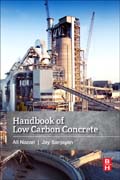
Handbook of Low Carbon Concrete brings together the latest breakthroughs in the design, production, and application of low carbon concrete. In this handbook, the editors and contributors have paid extra attention to the emissions generated by coarse aggregates, emissions due to fine aggregates, and emissions due to cement, fly ash, GGBFS, and admixtures. In addition, the book provides expert coverage on emissions due to concrete batching, transport and placement, and emissions generated by typical commercially produced concretes. Includes the tools and methods for reducing the emissions of greenhouse gasesExplores technologies, such as carbon capture, storage, and substitute cementsProvides essential data that helps determine the unique factors involved in designing large, new green cement plants INDICE: Greenhouse Gas Emissions Due to Concrete ManufactureLife Cycle CO 2 Evaluation on Reinforced Concrete Structures With High-Strength ConcreteAssessment of CO 2 Emissions Reduction in High-Rise Concrete Office Buildings Using Different Material-Use OptionsEco-Friendly Concretes With Reduced Water and Cement Content: Mix Design Principles and Experimental TestsEffect of Supplementary Cementitious Materials on Reduction of CO 2 Emissions From ConcreteBinder and Carbon Dioxide Intensity Indexes as a Useful Tool to Estimate the Ecological Influence of Type and Maximum Aggregate Size on Some High-Strength Concrete PropertiesCO 2 Reduction Assessment of Alkali-Activated Concrete Based on Korean Life-Cycle Inventory DatabaseIntroducing Bayer Liquor-Derived GeopolymersAlkali-Activated Cement-Based Binders (AACBs) as Durable and Cost-Competitive Low-CO 2 Binder Materials: Some Shortcomings That Need to be AddressedProgress in the Adoption of Geopolymer CementAn Overview on the Influence of Various Factors on the Properties of Geopolymer Concrete Derived From Industrial ByproductsPerformance on an Alkali-Activated Cement-Based Binder (AACB) for Coating of an OPC Infrastructure Exposed to Chemical Attack: A Case StudyAlkali-Activated Cement (AAC) From Fly Ash and High-Magnesium Nickel SlagBond Between Steel Reinforcement and Geopolymer ConcreteBoroaluminosilicate Geopolymers: Current Development and Future Potentials
- ISBN: 978-0-12-804524-4
- Editorial: Butterworth-Heinemann
- Encuadernacion: Rústica
- Páginas: 442
- Fecha Publicación: 03/10/2016
- Nº Volúmenes: 1
- Idioma: Inglés
